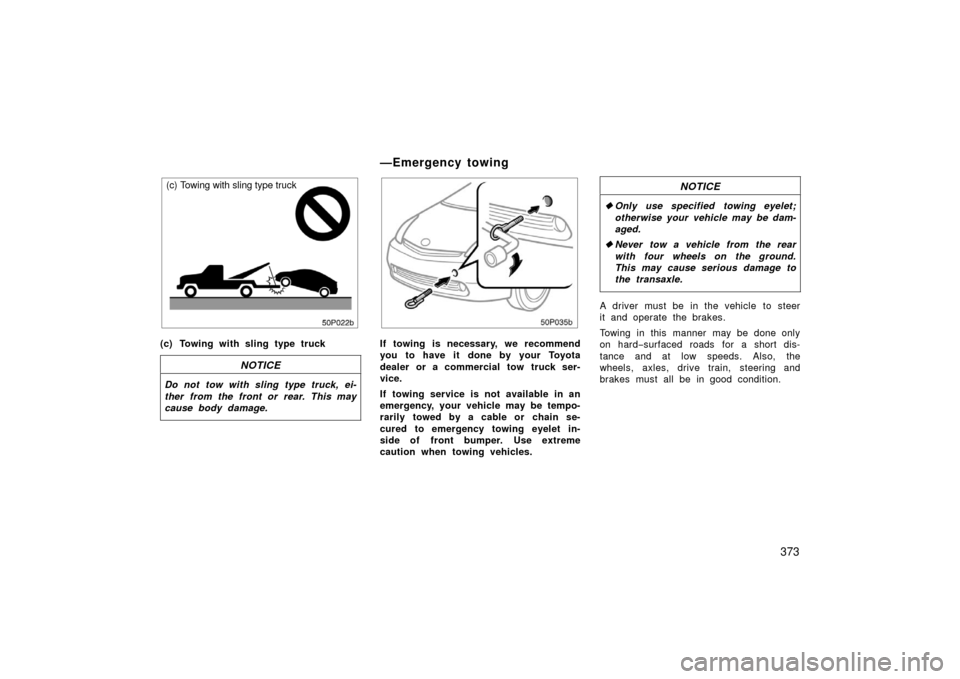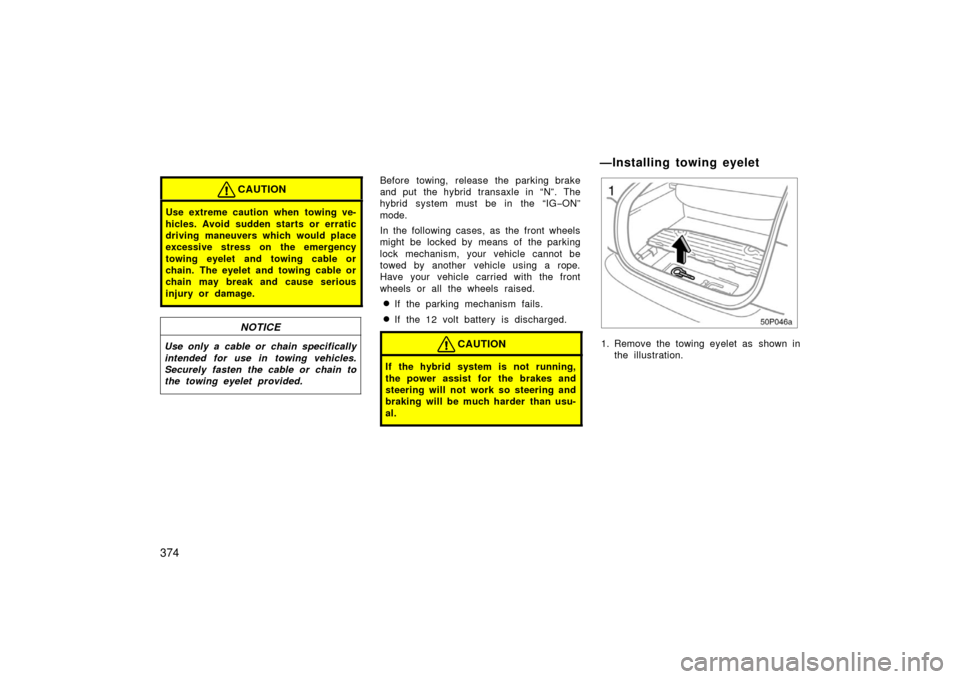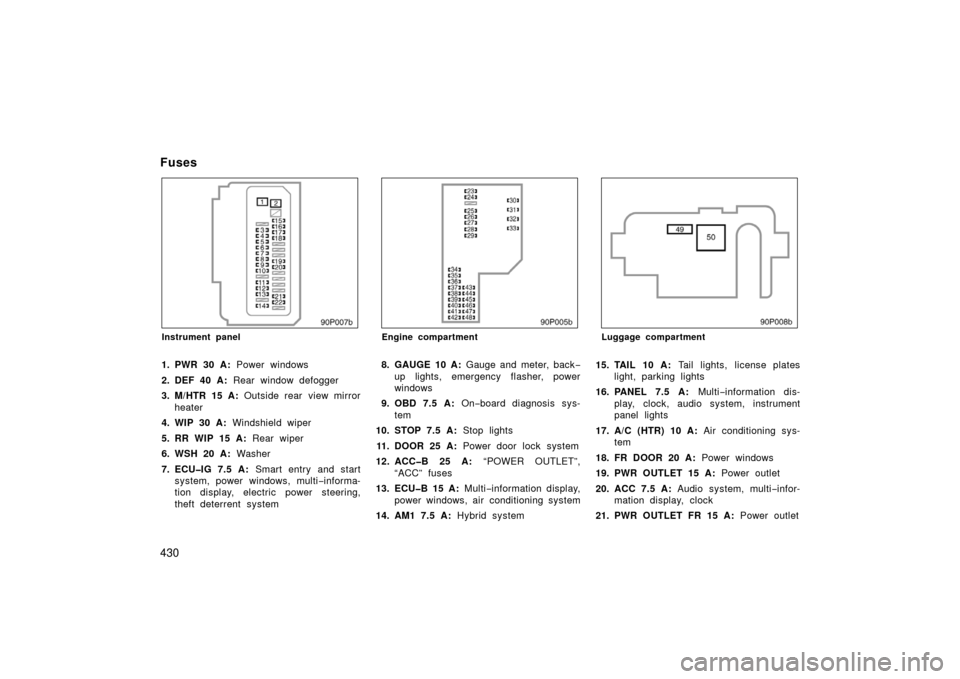Page 373 of 455

373
50p022b
(c) Towing with sling type truck
(c) Towing with sling type truck
NOTICE
Do not tow with sling type truck, ei-
ther from the front or rear. This may
cause body damage.
50p035b
If towing is necessary, we recommend
you to have it done by your Toyota
dealer or a commercial tow truck ser-
vice.
If towing service is not available in an
emergency, your vehicle may be tempo-
rarily towed by a cable or chain se-
cured to emergency towing eyelet in-
side of front bumper. Use extreme
caution when towing vehicles.
NOTICE
� Only use specified towing eyelet;
otherwise your vehicle may be dam-
aged.
� Never tow a vehicle from the rear
with four wheels on the ground.
This may cause serious damage to
the transaxle.
A driver must be in the vehicle to steer
it and operate the brakes.
Towing in this manner may be done only
on hard− surfaced roads for a short dis-
tance and at low speeds. Also, the
wheels, axles, drive train, steering and
brakes must all be in good condition.
—Emergency towing
Page 374 of 455

374
CAUTION
Use extreme caution when towing ve-
hicles. Avoid sudden starts or erratic
driving maneuvers which would place
excessive stress on the emergency
towing eyelet and towing cable or
chain. The eyelet and towing cable or
chain may break and cause serious
injury or damage.
NOTICE
Use only a cable or chain specifically
intended for use in towing vehicles.
Securely fasten the cable or chain to
the towing eyelet provided.
Before towing, release the parking brake
and put the hybrid transaxle in “N”. The
hybrid system must be in the “IG−ON”
mode.
In the following cases, as the front wheels
might be locked by means of the parking
lock mechanism, your vehicle cannot be
towed by another vehicle using a rope.
Have your vehicle carried with the front
wheels or all the wheels raised.
�If the parking mechanism fails.
�If the 12 volt battery is discharged.
CAUTION
If the hybrid system is not running,
the power assist for the brakes and
steering will not work so steering and
braking will be much harder than usu-
al.
50p046a
1. Remove the towing eyelet as shown in the illustration.
—Installing towing eyelet
Page 388 of 455

388
INSIDE THE VEHICLE
Items listed below should be checked
regularly, e.g. while performing periodic
services, cleaning the vehicle, etc.
Lights
Make sure the headlights, stop lights, tail
lights, turn signal lights, and other lights
are all working. Check headlight aim.
Service reminder indicators and warning
buzzers
Check that all service reminder indicators
and warning buzzers function properly.
Steering wheel
Be alert for changes in steering condition,
such as hard steering or strange noise.
Seats
Check that all front seat controls such as
seat adjusters, seatback recliner, etc. op-
erate smoothly and that all latches lock
securely in any position. Check that the
head restraint move up and down smooth-
ly and that the locks hold securely in any
latched position.Seat belts
Check that the seat belt system such as
buckles, retractors and anchors operate
properly and smoothly. Make sure the belt
webbing is not cut, frayed, worn or dam-
aged.
Accelerator pedal
Check the pedal for smooth operation and
uneven pedal effort or catching.
Brake pedal
Check the pedal for smooth operation and
that the pedal has the proper clearance.
Check the brake booster function.
Brakes
In a safe place, check that the brakes do
not pull to one side when applied.
Parking brake
Check that the pedal has the proper travel
and that, on a safe incline, your vehicle
is held securely with only the parking
brake applied.
OUTSIDE THE VEHICLE
Items listed below should be performed
from time to time, unless otherwise
specified.
Fluid leaks
Check underneath for leaking fuel, oil, wa-
ter or other fluid after the vehicle has
been parked for a while. If you smell fuel
fumes or notice any leak, have the cause
found and corrected immediately.
Doors and engine hood
Check that all doors and trunk operate
smoothly and all latches lock securely.
Make sure the engine hood secondary
latch secures the hood from opening when
the primary latch is released.
Tire inflation pressure
Check the pressure with a gauge ev-
ery two weeks, or at least once a
month. See page 405 for additional
information.
Page 429 of 455

429
12 VOLT BATTERY
Open voltage at 20�C (68 �F):
12.6 − 12.8 V Fully charged
12.2 − 12.4 V Half charged
11 . 5 − 11.9 V Discharged
[Voltage that is checked 20 minutes after
the key is removed with all the lights
turned off]
Charging rates: 3.5 A max.
HYBRID TRANSAXLE
Fluid capacity (drain and refill),
L (qt., Imp.qt.): 3.6 (3.8, 3.2)
Fluid type: “Toyota Genuine ATF WS” or
equivalent
Please contact your Toyota dealer for further
details. BRAKES
Minimum pedal clearance when depressed
with the force of 196 N (20 kgf, 44 lbf)
with the traction motor running, mm (in.):
101.0 (3.98)
Pedal free play, mm (in.): 1 − 4 (0.04 − 0.16)
Parking brake adjustment when depressed
with the force of 294 N (30 kgf, 66 lbf): 6 − 9 clicks
Fluid type: SAE J1703 or FMVSS No. 116 DOT 3
STEERING
Wheel free play: Less than 30 mm (1.2 in.)
Tires
Tire size and inflation pressure:
Tire size kPa (kgf/cm
2 or ba r, ps i )
Standard Front
P185/65R15 86S 240 (2. 4, 35)
Rear
P185/65R15 86S 230 (2. 3, 33)
Spare T125/70D16 96M 420 (4. 2, 60)
Wheel size: Standard 15 x 6JJ
S par e 16 x 4T
Wheel nut torque, N·m (kgf·m,
ft·lbf): 103 (10.5, 76)
NOTE: For a complete information on tires (e.g. replacing tires
or replacing wheels), see
“Checking tire inflation pres-
sure” through “Aluminum
wheel precautions”, page
405 through 412.
Page 430 of 455

430
90p007b
Instrument panel
1. PWR 30 A: Power windows
2. DEF 40 A: Rear window defogger
3. M/HTR 15 A: Outside rear view mirror
heater
4. WIP 30 A: Windshield wiper
5. RR WIP 15 A: Rear wiper
6. WSH 20 A: Washer
7. ECU�IG 7.5 A: Smart entry and start
system, power wi ndows, multi−informa-
tion display, electric power steering,
theft deterrent system
90p005b
Engine compartment
8. GAUGE 10 A: Gauge and meter, back −
up lights, emergency flasher, power
windows
9. OBD 7.5 A: On−board diagnosis sys-
tem
10. STOP 7.5 A: Stop lights
11. DOOR 25 A: Power door lock system
12. ACC�B 25 A: “POWER OUTLET”,
“ACC” fuses
13. ECU�B 15 A: Multi−information display,
power windows, air conditioning system
14. AM1 7.5 A: Hybrid system
90p008b
Luggage compartment
15. TAIL 10 A: Tail lights, license plates
light, parking lights
16. PANEL 7.5 A: Multi−information dis-
play, clock, audio system, instrument
panel lights
17. A/C (HTR) 10 A: Air conditioning sys-
tem
18. FR DOOR 20 A: Power windows
19. PWR OUTLET 15 A: Power outlet
20. ACC 7.5 A: Audio system, multi −infor-
mation display, clock
21. PWR OUTLET FR 15 A: Power outlet
Fuses
Page 441 of 455

441
�SRS airbag deployment data
� SRS airbag system diagnostic
data
If your vehicle is equipped with a
vehicle stability control (VSC) sys-
tem, its Electronic Control Unit
(ECU) may contain another EDR.
There are a variety of driving situ-
ations which include activating the
VSC under which the VSC EDR
will record certain information. The
VSC EDR may record some or all
of the following information:
� Behavior of the vehicle
� Steering wheel angle
� Vehicle speed
� To what extent the accelerator
pedal was depressed
� To what extent the brake ped-
al was applied
� To what extent the ECU con-
trolled the condition of the 4
wheels
� Vehicle stability control sys-
tem diagnostic data
The information above is intended
to be used for the purpose of im-
proving vehicle safety perfor-
mance. Unlike general data record-
ers, the EDR does not record
sound data such as conversation
between passengers.Toyota will not disclose the data
recorded in an EDR to a third
party except when:
� An agreement from the ve-
hicle’s owner (or the leasing
company for a leased vehicle)
is obtained
� Officially requested by the po-
lice or other authorities
� Used as a defence for Toyota
in a law suit
� Ordered by the court
However, if necessary Toyota will:
� Use the data for research on
Toyota vehicle safety perfor-
mance
� Disclose the data to a third
party for research purposes
without disclosing details of
the vehicle owner, and only
when it is deemed necessary
� Disclose summarized data
cleared of vehicle identifica-
tion information to a non −To -
yota organization for research
purposes
Page 446 of 455

446
Smart entry and startsystem
Users of any electrical medical de-
vices such as implanted pacemak-
ers should consult the manufactur-
er of the device for information
about its operation under the influ-
ence of radio waves. Radio waves
could have unexpected effects on
the operation of such medical de-
vices. For details, see “Keys” on
page 20 and “Smart entry and
start system” on page 24 in Sec-
tion 2−1.
Tires and loading on
your Toyota
Underinflated or overinflated
tire inflation pressure and the
excess load may result in the
deterioration of steering ability
and braking ability, leading to
an accident. Check the tire
inflation pressure periodically
and be sure to keep the load
limits given in this Owner ’s
Manual. For details about tire
inflation pressure and load lim-
its, see page 405 and pages
342.
Scrapping of your Toyota
The SRS airbag and seat belt pre-
tensioner devices in your Toyota
contain explosive chemicals. If the
vehicle is scrapped with the airbags
and pretensioners left as they are,
this may cause an accident such as
fire. Be sure to have the systems
of the SRS airbag and seat belt
pretensioner removed and disposed
of by the qualified service shop or
by your Toyota dealer before you
dispose of your vehicle.